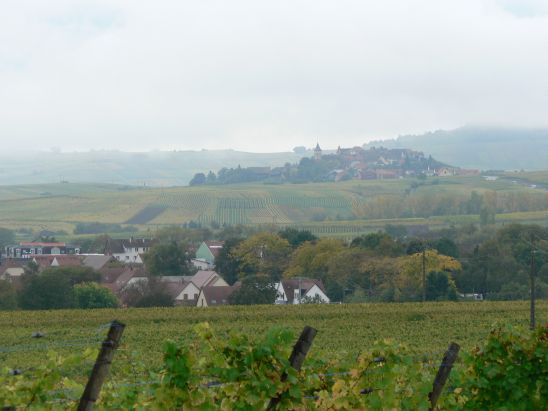Today’s destination is Colmar, a pretty large city to the south of here. But first a few scenes along the way.
This scene just south of Bergheim caught our eyes, and we pulled over to the side of the road to capture it.
And shortly thereafter, the hilltop town of Zellenberg which we visited on Sunday came into view. So here it is, in context.
Then we continued southward to Kaysersberg, birthplace of Albert Schweitzer. Yes, he is one more of those people whose name sounded German to all of us but was indeed from Alsace. Bruce’s favorite example of this phenomenon is the composer Émile Waldteufel (meaning ‘devil of the forest’). You can't get a last name that sounds much more German than that! I wonder if he had any inkling that two of his works would later show up in a Rheingold beer commercial and as the tune of Perry Como’s 1950s song Hot Diggity Dog. He is probably better known for the The Skaters Waltz. How do I know all this? I listened to Renée Chaney and Dennis Owens, drive time hosts on WGMS, during 30 years of commuting in Maryland.
The town really does need to do a better job with the signs, because it took us quite a while (and asking directions) before we finally located Schweitzer’s birthplace and the associated museum. But that was OK, because there were lots of other interesting things to look at, plus a tasty lunch.
So, first a few scenes along the main street.
Alsace isn’t all about wine. Remember, it was part of Germany for quite a while, three times.
Some extra special local brews
Truth Serum Spider Venom Rat Poison
Classic shop signs.
Trash and recycling bins for the visually oriented or the foreigner.
Maybe with a bit of Photoshop we could fit our grandkids into these.
Commemoration of the 1944 liberation of Kayserberg by the Third Infantry Division
The Rock of the Marne
We saw similar signs throughout the area. This is one of the few examples of English we have seen.
View up the hill, including part of the original wall.
Another insect hotel. Now we know what these are.
We finally located the Albert Schweitzer Museum and his adjacent birthplace.
It was closed for the typical two-hour lunch, so we didn’t get to go in.
Albert Schweitzer’s birthplace in the center, and the museum on the right
Albert Schweitzer’s birthplace in the center, and the museum on the right
A statue in the adjacent park
We enjoyed a tasty lunch of Quiche Lorraine and Quiche avec légumes at the restaurant Péché Mignon. Which translates to a ‘Small Sin’.
This painting above the door is a mystery on many levels. For one, why is the grown man/angel/chef holding his left ankle while balancing a large heavy cake and platter with his right hand?
Then we continued south to Colmar. It’s a pretty big place and we had a hard time finding the tourist office or even a map, but we managed nonetheless. A part of it is called Petite Venise (Little Venice), as there are canals running through it, and tours in little boats about the size of small vaporetto (powered by a small electric motor rather than a pole, though there was a pole available for use in case of power failure).
The small boats stem from a time when they were used to bring in produce to the city market. Learning this explains our earlier observation of a number of doors at the market hall that open up directly onto the canal. The market itself was huge, but sparsely populated, recently renovated, very clean and shiny, and generally not the bustling experience one typically gets in European markets. But the chocolate éclair was delicious.
In reading about this area later, we found some visitors who felt that the area would better be named Petit Bruges, after the lovely city in Belgium that we visited in the course of a number of trips from England over to the Continent. Venice is totally canals, whereas Bruges and Colmar are a very pleasant mix.
The boat ride took us through parts of the city, and then we abruptly crossed into the very different countryside—where the rich people live. The boatman pointed out one bridge over the canal that was built by the US Army in three days near the end of World War II, and is still doing fine.
Here are a few views along the canal.
The red outcropping high up on the building in the center was an original toilet. It relied on gravity and the water of the canal to carry away the waste products. No, it is no longer in use.
And then we met this surprise on the way out of town. Frédéric Auguste Bartholdi, the sculptor of the Statue of Liberty, was a native of Colmar. His name was celebrated throughout town, but we weren’t prepared to encounter this in the middle of the roundabout. We made two or three circles around it before being able to retrieve the camera from the back seat and get off this quick shot.
A nice wrapup to the day
And a special note to the iPad/iPhone people - We have found a way around Blogger’s default of showing videos in Flash and have now reformatted all those earlier ones that you couldn’t watch. They’re also a good bit larger than they used to be.
A nice wrapup to the day
And a special note to the iPad/iPhone people - We have found a way around Blogger’s default of showing videos in Flash and have now reformatted all those earlier ones that you couldn’t watch. They’re also a good bit larger than they used to be.





















No comments:
Post a Comment